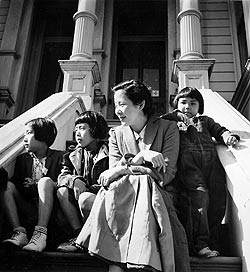Berkeleyan
Bancroft Library exhibit highlights half a century of regional oral history
![]()
| 27 October 2004
 Photos in the Bancroft’s ROHO exhibit add visual counterpoint to the oral histories it celebrates. In this Dorothea Lange image, a Japanese American family awaits evacuation from San Francisco to an internment camp during World War II. (Dorothea Lange photo, courtesy The Bancroft Library.) |
The office boasts an inventory of more than 2,000 oral histories that trace California’s evolution over the last half-century in such fields as politics and government, business and labor, the environment, technology, the arts, and University of California history.
Interviewees range from Quaker suffragist Alice Paul to Nobel laureate (and Berkeley emeritus professor) Charles Townes, from environmentalist David Brower to civil-rights activist Frances Mary Albrier, from bus drivers and concert musicians to shipyard welders who migrated to California from the Jim Crow South and the Dust Bowl.
The collection — in print, audio, and video formats — follows a path set by historian Hubert Howe Bancroft, for whom the library housing it is named. In the 1860s, Bancroft set out to interview and create autobiographies of some of the West’s pioneers, with the intention of rounding out his already extensive collection of books, maps, journals, and manuscripts.
“Oral history works because we all are participants in oral culture,” says Richard Cándida Smith, a professor of history who is ROHO’s director. “Decisions are codified and rationalized in writing, but they are arrived at through a lengthy process of oral exchange.”
 Student transcribers Sam Schramski and Kirstin Jackson at work at ROHO. (Gerald Stone photo) |
In a nearby exhibit case is a minidisk recorder, a device commonly used by oral historians today that is a fraction of the size of the large, clunky tape recorder used to record eight reels of recollections by Toklas.
Space devoted to Alice Paul’s oral history reveals that getting history-makers to sit down for an interview can be a challenge in itself; they are often too busy to reflect on the past. Interviewer Amelia Frey had to promise the prominent suffragist that she would work on the campaign to pass the Equal Rights Amendment.
ROHO conducted oral histories with both the legendary photographer Dorothea Lange and her husband, the late Berkeley economist Paul Taylor. A display of Lange’s photos focuses attention on both the Depression and World War II, with images of the Dust Bowl poor who headed west in search of jobs in California’s fields and orchards, as well as some of her photos of Japanese internment camps.
The rest of the Bancroft exhibit touches on the oral histories of such figures as the writer Wallace Stegner, chef Heidi Krahling, Life magazine photographer Wayne Miller, jazz great Dave Brubeck, scientists who worked on the atom bomb, and contemporary biotechnologists and entrepreneurs. An Internet station at the exhibit allows visitors to explore still more of ROHO’s archived interviews and watch video histories online.
Link:

